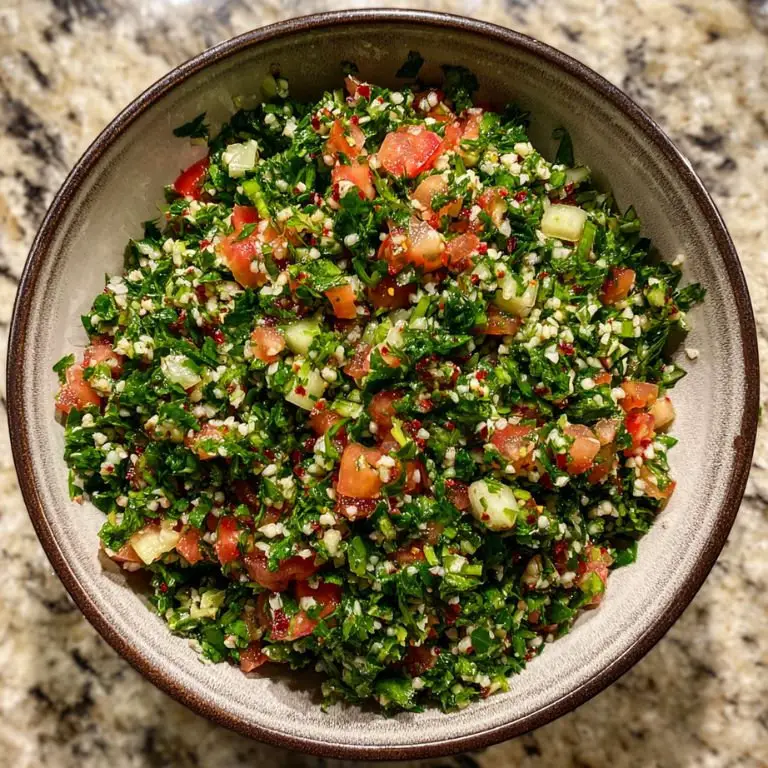Tabouli is one of those dishes that never gets old. It’s fresh, herbaceous, and vibrant — the kind of salad that wakes up your palate and makes you feel good after eating it. This Whole Wheat Bulgur Tabouli with Sumac and Garlic version takes everything you love about the authentic tabbouleh recipe and adds a bold punch of tangy sumac and the savory depth of garlic. It’s still light and zesty but with a slightly earthier profile thanks to the whole wheat bulgur and the added aromatics. Perfect as part of a lebanese mezze, a middle eastern side dish, or even a stand-alone lunch, this recipe brings all the charm of lebanese cuisine right to your table.
Whole Wheat Bulgur Tabouli with Sumac and Garlic
Prep Time 25 minutes mins
Total Time 25 minutes mins
Course Appetizer, Salad
Cuisine Middle Eastern
Servings 4 as a main dish, 6–8 as a side
Large Mixing Bowl for combining all the ingredients evenly
Medium bowl to soak the bulgur
Fine mesh strainer to drain excess water from the bulgur
Sharp knife for finely chopping herbs and veggies
Cutting board preferably two (one for herbs, one for tomatoes to avoid sogginess)
Garlic press (optional) if you want a smoother garlic texture
Citrus juicer (optional) makes juicing lemons easier, but not necessary
For the Salad
- 1 cup fine whole wheat bulgur
- 2 cups hot water
- 2 large bunches flat-leaf parsley finely chopped (about 2 cups packed)
- 1/2 cup fresh mint leaves finely chopped
- 4 medium tomatoes diced small
- 1/2 English cucumber seeded and finely diced (optional for added crunch)
- 4 scallions thinly sliced (white and green parts)
- 3 garlic cloves minced
- 1 1/2 teaspoons ground sumac
- Juice of 2 large lemons about 1/4 cup
- 1/4 cup extra virgin olive oil
- Salt and freshly ground black pepper to taste
Optional Add-ins
- 1/4 teaspoon allspice or cinnamon for subtle warmth
- A sprinkle of pomegranate seeds for a sweet contrast
- Chopped romaine lettuce for texture if serving as part of a fatteh recipe
Step 1: Soak the Bulgur
In a medium bowl, combine the whole wheat bulgur and hot water. Let it soak for 15–20 minutes until soft but still slightly chewy. Once ready, drain off any excess water using a fine mesh strainer. Press down gently to remove as much moisture as possible — this keeps your salad from getting soggy.
Step 2: Prep the Herbs and Vegetables
While the bulgur is soaking, finely chop the parsley and mint. The key to a great lebanese tabbouleh recipe with bulgur wheat is in the texture — you want everything chopped small and even. Dice the tomatoes, cucumbers (if using), and slice the scallions thinly.
Step 3: Build the Base
In a large mixing bowl, combine the soaked bulgur, parsley, mint, tomatoes, cucumber, scallions, and minced garlic. Sprinkle in the sumac — this gives the salad a lemony lift that’s extra refreshing.
Step 4: Dress and Season
Drizzle the lemon juice and olive oil over the salad. Toss everything gently but thoroughly to combine. Season with salt and pepper to taste. Let the salad rest for at least 10 minutes to allow the flavors to meld — even better if you refrigerate it for 30 minutes.
Step 5: Serve and Enjoy
Serve chilled or at room temperature. This tabuli salad shines on its own or as part of a bigger lebanese dinner spread.
Pairings
This tabbouleh salad recipe is incredibly versatile and works with a variety of dishes, especially within middle eastern salad and lebanese salad recipes traditions.
- Grilled Chicken or Lamb: Pair this with grilled sumac-spiced chicken or lamb kofta for a complete meal.
- Fatteh Recipe: Serve alongside crispy pita with hummus and yogurt — tabouli adds freshness to the creamy and crunchy layers.
- Maklouba Recipe: The richness of maklouba (a layered rice, meat, and vegetable dish) is beautifully offset by the acidity and herbs in tabouli.
- Falafel: A scoop of tabouli inside a falafel wrap makes every bite fresh and juicy.
- Stuffed Grape Leaves: As part of a Lebanese mezze, tabouli plays well with dolmas, labneh, and olives.
FAQs
1. Can I use regular bulgur instead of whole wheat?
Yes, but the whole wheat variety gives the dish a nuttier, more complex flavor and is often more nutritious. Just be sure to use fine bulgur (not coarse or cracked) for the best texture.
2. What kind of parsley should I use?
Always go with flat-leaf parsley, not curly. It has a stronger flavor and a better texture for tabouli.
3. Can I make this ahead of time?
Absolutely. In fact, tabouli tastes even better after a few hours in the fridge. Just be sure to give it a good toss before serving.
4. How is this different from a classic tabbouleh recipe?
This version adds sumac and garlic, and it uses whole wheat bulgur instead of regular, making it a bit more robust. But it still holds true to what makes Lebanese recipes authentic — fresh herbs, lemon, and olive oil.
5. Is this dish vegetarian or vegan?
Yes to both! It’s made entirely of plant-based ingredients, making it one of the best vegetarian tabbouleh ingredients lists you’ll find. It’s a staple in many Lebanese salad recipes and is always a crowd-pleaser.
